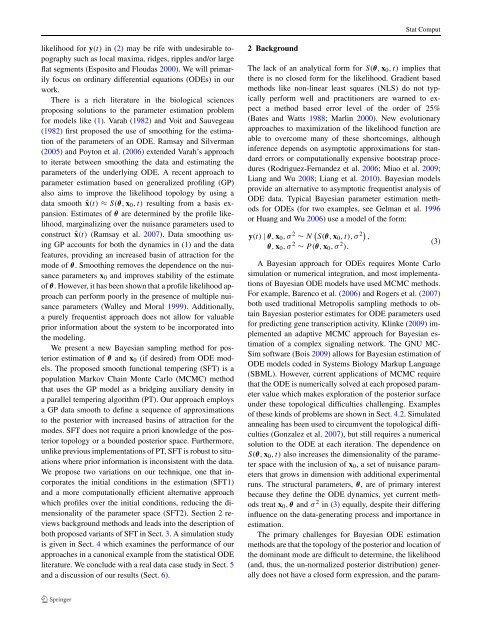Smooth functional tempering for nonlinear differential equation models
Smooth functional tempering for nonlinear differential equation models
Smooth functional tempering for nonlinear differential equation models
Create successful ePaper yourself
Turn your PDF publications into a flip-book with our unique Google optimized e-Paper software.
Stat Computlikelihood <strong>for</strong> y(t) in (2) may be rife with undesirable topographysuch as local maxima, ridges, ripples and/or largeflat segments (Esposito and Floudas 2000). We will primarilyfocus on ordinary <strong>differential</strong> <strong>equation</strong>s (ODEs) in ourwork.There is a rich literature in the biological sciencesproposing solutions to the parameter estimation problem<strong>for</strong> <strong>models</strong> like (1). Varah (1982) and Voit and Sauvegeau(1982) first proposed the use of smoothing <strong>for</strong> the estimationof the parameters of an ODE. Ramsay and Silverman(2005) and Poyton et al. (2006) extended Varah’s approachto iterate between smoothing the data and estimating theparameters of the underlying ODE. A recent approach toparameter estimation based on generalized profiling (GP)also aims to improve the likelihood topology by using adata smooth ˆx(t) ≈ S(θ, x 0 ,t) resulting from a basis expansion.Estimates of θ are determined by the profile likelihood,marginalizing over the nuisance parameters used toconstruct ˆx(t) (Ramsay et al. 2007). Data smoothing usingGP accounts <strong>for</strong> both the dynamics in (1) and the datafeatures, providing an increased basin of attraction <strong>for</strong> themode of θ. <strong>Smooth</strong>ing removes the dependence on the nuisanceparameters x 0 and improves stability of the estimateof θ. However, it has been shown that a profile likelihood approachcan per<strong>for</strong>m poorly in the presence of multiple nuisanceparameters (Walley and Moral 1999). Additionally,a purely frequentist approach does not allow <strong>for</strong> valuableprior in<strong>for</strong>mation about the system to be incorporated intothe modeling.We present a new Bayesian sampling method <strong>for</strong> posteriorestimation of θ and x 0 (if desired) from ODE <strong>models</strong>.The proposed smooth <strong>functional</strong> <strong>tempering</strong> (SFT) is apopulation Markov Chain Monte Carlo (MCMC) methodthat uses the GP model as a bridging auxiliary density ina parallel <strong>tempering</strong> algorithm (PT). Our approach employsa GP data smooth to define a sequence of approximationsto the posterior with increased basins of attraction <strong>for</strong> themodes. SFT does not require a priori knowledge of the posteriortopology or a bounded posterior space. Furthermore,unlike previous implementations of PT, SFT is robust to situationswhere prior in<strong>for</strong>mation is inconsistent with the data.We propose two variations on our technique, one that incorporatesthe initial conditions in the estimation (SFT1)and a more computationally efficient alternative approachwhich profiles over the initial conditions, reducing the dimensionalityof the parameter space (SFT2). Section 2 reviewsbackground methods and leads into the description ofboth proposed variants of SFT in Sect. 3. A simulation studyis given in Sect. 4 which examines the per<strong>for</strong>mance of ourapproaches in a canonical example from the statistical ODEliterature. We conclude with a real data case study in Sect. 5and a discussion of our results (Sect. 6).2 BackgroundThe lack of an analytical <strong>for</strong>m <strong>for</strong> S(θ, x 0 ,t) implies thatthere is no closed <strong>for</strong>m <strong>for</strong> the likelihood. Gradient basedmethods like non-linear least squares (NLS) do not typicallyper<strong>for</strong>m well and practitioners are warned to expecta method based error level of the order of 25%(Bates and Watts 1988; Marlin 2000). New evolutionaryapproaches to maximization of the likelihood function areable to overcome many of these shortcomings, althoughinference depends on asymptotic approximations <strong>for</strong> standarderrors or computationally expensive bootstrap procedures(Rodriguez-Fernandez et al. 2006; Miaoetal.2009;Liang and Wu 2008; Liang et al. 2010). Bayesian <strong>models</strong>provide an alternative to asymptotic frequentist analysis ofODE data. Typical Bayesian parameter estimation methods<strong>for</strong> ODEs (<strong>for</strong> two examples, see Gelman et al. 1996or Huang and Wu 2006) use a model of the <strong>for</strong>m:y(t) | θ, x 0 ,σ 2 ∼ N ( S(θ, x 0 ,t),σ 2) ,θ, x 0 ,σ 2 ∼ P(θ, x 0 ,σ 2 ).A Bayesian approach <strong>for</strong> ODEs requires Monte Carlosimulation or numerical integration, and most implementationsof Bayesian ODE <strong>models</strong> have used MCMC methods.For example, Barenco et al. (2006) and Rogers et al. (2007)both used traditional Metropolis sampling methods to obtainBayesian posterior estimates <strong>for</strong> ODE parameters used<strong>for</strong> predicting gene transcription activity. Klinke (2009) implementedan adaptive MCMC approach <strong>for</strong> Bayesian estimationof a complex signaling network. The GNU MC-Sim software (Bois 2009) allows <strong>for</strong> Bayesian estimation ofODE <strong>models</strong> coded in Systems Biology Markup Language(SBML). However, current applications of MCMC requirethat the ODE is numerically solved at each proposed parametervalue which makes exploration of the posterior surfaceunder these topological difficulties challenging. Examplesof these kinds of problems are shown in Sect. 4.2. Simulatedannealing has been used to circumvent the topological difficulties(Gonzalez et al. 2007), but still requires a numericalsolution to the ODE at each iteration. The dependence onS(θ, x 0 ,t) also increases the dimensionality of the parameterspace with the inclusion of x 0 , a set of nuisance parametersthat grows in dimension with additional experimentalruns. The structural parameters, θ, are of primary interestbecause they define the ODE dynamics, yet current methodstreat x 0 , θ and σ 2 in (3) equally, despite their differinginfluence on the data-generating process and importance inestimation.The primary challenges <strong>for</strong> Bayesian ODE estimationmethods are that the topology of the posterior and location ofthe dominant mode are difficult to determine, the likelihood(and, thus, the un-normalized posterior distribution) generallydoes not have a closed <strong>for</strong>m expression, and the param-(3)
















